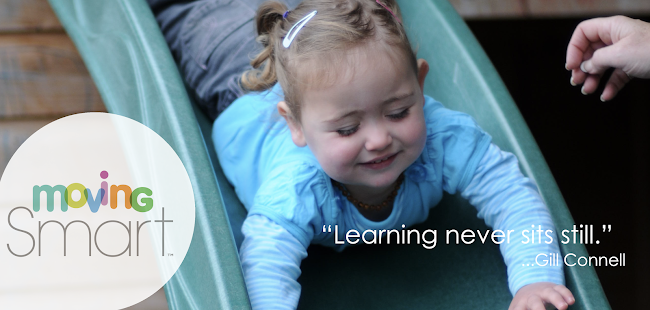I'm so pleased to introduce Wendy Pirie, our first-ever guest blogger. Wendy is part of the Moving Smart family in the Hawke's Bay area, joining us a year ago after completing her Masters in Perceptual Motor Development. Wendy works with schools, preschools, parents, and children and, like me, is a lifelong advocate of children's natural wiggling, giggling way of learning!
We all know that most Olympians have spent a fair share of their lives in the gym, in the pool, or on the track preparing for their Olympic moment. They embody dedication to perfection. But when you compare that training regimen to what a preschooler goes through everyday, it's just possible our Olympians need to take a few more laps if they want to keep up with our little ones.
The other day I had the pleasure of participating in the Gumboots Kindergarten tribute to the Olympics! This is a photograph of my son Carter jumping his very first hurdle! Like an Olympian, it's taken him years to perfect his skills in preparation for this event. But now put that in perspective. He will turn four next month which means three years ago, he took his very first step. That's advancement on an Olympic scale, and it happens one tiny step at a time.
So let's take a look at what it takes to clear your first hurdle...
CLEARING HURDLES
The Hurdles is a sport for masters of speed, strength, agility, and balance. But there's actually a lot more to it than that... and it all begins in early childhood...
LATERALITY
Leaping is the signature skill of a great hurdler, and demonstrates a high degree of proficiency in Lateral Movement skills.
Laterality is the ability to move arms and legs in opposition to one another. It begins when babies first start crawling, walking, and running, and continues to be refined through the early school years.
LEAPING
Leaping -- jumping into the air off of one foot -- is an advanced skill that comes after much practice with the everydayness of walking and running (taking one foot off the ground at a time). Over time, a child's natural instinct to move his body in different ways progresses to two-footed jumping in place, followed by two-footed jumping forwards, backwards, and side to side, and eventually leaping off of one foot (usually from the couch).
But it will probably take some more time before he can put the run-leap-run combination together (without tripping over his own feet). The rhythm and timing to successfully "switch gears" mid-stride signals more that physical coordination. It's an indication that body-brain communication is reaching a refined state. And when that happens, he'll be able to turn his focus and attention to more important matters, like deciding what he's going to leap over next!
TEMPORAL AWARENESS
The ability to judge distance either while standing still or moving is a hurdler's best friend. Without it... ouch!
You see, understanding where the hurdle is, how fast you are running, and calculating -- on the run -- the exact right moment to "lift off" is a complex body-brain-environment triangulation that can only happen after years of experience with motion -- his own movements and the comings and goings of the people, places, and things around him.
And that's no small feat for big or little feet.
Happy Olympics, everyone.
Go Team New Zealand!
Thanks to the Gumboots Kindergarten team for allowing me to participate in your tribute to the Olympics. A lot more winning went on that day than just the gold medals that were handed out.
To contact Wendy in Hawke's Bay area for Moving Smart courses and resources...
Wendy Pirie
Moving Smart Ltd.
wendy.pirie@movingsmart.co.nz
+64 273 296 776BAREFOOTIN' BEANS
Bean bags are so versatile. They're fun to throw, catch, balance with, and the wibbly-wobbly crunchy feel is great tactile experience for little hands. And little feet too!
Here's a super-simple game for preschoolers that enhances skills they'll need -- laterality, balance, concentration, amongst others -- to be able to clear all the hurdles they want some day.
SET UP
Line up bean bags in two straight rows like stepping stones. If you have enough, use one color for the left row and another color for the right row to make it easy for the child to spot the difference.
Now, take off your shoes and socks and you're reading to start.
WARM UP
Standing at the top of the two rows, have the child walk on the bean bags any way they'd like.
CROSS-STEPPING
Next, have the child walk down the rows, stepping his right foot on the left row of beans and his left foot on the right row. (Easy as this sounds, little ones might need a little support with this one, so be standing by.)
Have fun!










During one of the Olympics, we had our own Olympics in the back yard. Most of the events were just variations on standard party games, but by representing them in a pretend Olympic format, it turned out to be a bit hit.
ReplyDeleteShot putt became tossing a beach ball into a laundry hamper. Discus was Frisbee throwing at a target (instead of for distance, so we wouldn’t lose it over the fence.) Because my yard’s not that big, speed races lapped back and forth from the fence on one side of the yard to the other. Because our “contestants” ages ranged from about 2 to 8, we equalized the challenges my making older kids throw off-handed and, of course, starting lines were moved up for the little ones. Some times we’d announce the judging criteria after the event to make sure everyone would win something.
Gwynn